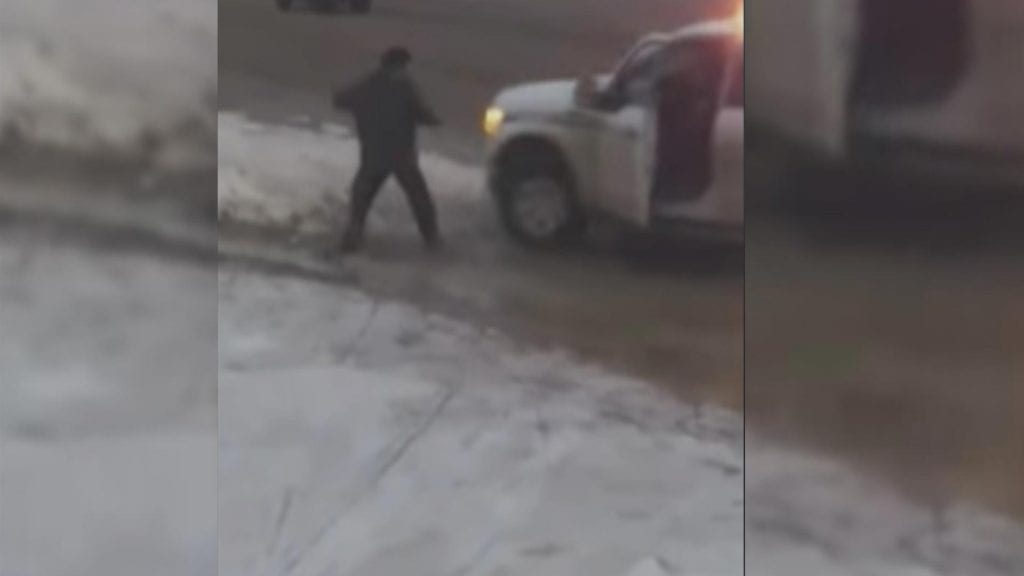
Ottawa police will not be charging the RCMP officer who struck this man with a door during an arrest in Kinngait
An external investigation concludes the Nunavut Mountie who knocked a Kinngait man down with the open door of a moving police vehicle in June didn’t do it on purpose and so won’t be charged with a criminal offence.
“The RCMP officer driving the vehicle did not intentionally strike the community member with the vehicle door,” said the Ottawa Police Service (OPS) in a news release Tuesday.
“The vehicle came to a sliding stop on a snow- and ice-covered track, the driver’s front tire went off the track, the vehicle dipped forward and the opened driver’s door swung forward and struck the community member.”
OPS has a memorandum of understanding with the RCMP in Nunavut and the territorial Justice Department to conduct third-party investigations of critical incidents involving civilians and police.
They launched one of these investigations on June 4, three days after the arrest was caught on video and went viral. The incident garnered national media attention and criticism from federal politicians.
Watch video of the arrest:
The short clip shows an Inuk man from the small community stumbling in the slush when a truck with its door open crashes into him, sending him sailing forward. The officer jumps out and starts to arrest the man and more officers soon arrive and swarm him.
“The OPS concluded that this does not meet the threshold of a criminal offence of an assault or assault with a weapon under the Criminal Code of Canada as the applied force was unintentional,” said Ottawa police in the release.
“Investigators also deemed that that was no evidence of dangerous operation of a conveyance or criminal negligence and further concluded that the arrest was lawful.”
The man was detained for public intoxication and was later injured after another inmate attacked him while in custody.
Read More:
RCMP watchdog to review door strike arrest in Kinngait
Two Ottawa criminal investigators reached their conclusions after interviewing 14 civilian and police witnesses, as well as examining video, the scene and the vehicle.
Nunavut RCMP acknowledged the external investigation’s conclusion, but refused to comment as an internal review process is ongoing, while the RCMP’s independent watchdog agency is still looking into the arrest.
The Civilian Review and Complaints Commission (CRCC) initiated the review in August.
“I am concerned with the conduct of RCMP members involved in this serious incident and will monitor both the OPS investigation and the RCMP’s Code of Conduct investigation,” chairperson Michelaine Lahaie said at the time.
“I am aware that there is historical distrust by Inuit toward the police and I am committed to increasing RCMP accountability.”
The arrest happened only days after police in the United States killed an unarmed Black man named George Floyd, sparking a world-wide reckoning of systemic racism and police brutality.

Chantel Moore, a 26-year-old Tla-o-qui-aht First Nation mother, was killed by municipal police in Edmundston, N.B. on June 4, the same day as the OPS investigation began.
Less than 10 days later, a Mi’kmaw man named Rodney Levi, 48, was Tasered, shot and killed by New Brunswick RCMP while attending a barbecue at his pastor’s house.
Meanwhile, Athabasca Chipewyan Chief Allan Adam came forward with allegations that the RCMP in Fort McMurray, Alta. assaulted him after stopping him for an expired licence plate.
The spate of violence spurred protests across Canada, which Prime Minister Justin Trudeau answered in his 2020 throne speech with a pledge to reform the federal police.
Some advocates also called for mandatory body cameras for front-line police officers following the dooring in Kinngait.
On Monday, Trudeau said Ottawa will spend $238.5 million over six years to implement a national body camera program for the RCMP.
It will be implemented first in Nunavut.










